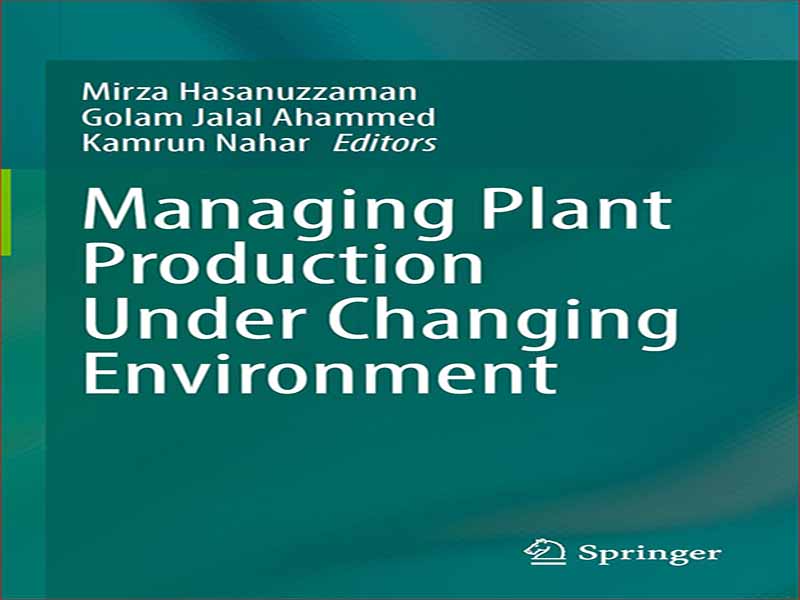- عنوان کتاب: Managing Plant Production Under Changing Environment
- نویسنده: Mirza Hasanuzzaman
- حوزه: مهندسی کشاورزی
- سال انتشار: 2022
- تعداد صفحه: 488
- زبان اصلی: انگلیسی
- نوع فایل: pdf
- حجم فایل: 8.37 مگابایت
انتظار می رود جمعیت جهان در سال 2050 به 9.8 میلیارد نفر برسد، اما زمین های کشاورزی به همان سرعت گسترش نخواهند داد. در حال حاضر، از هر نه نفر در سراسر جهان، یک نفر از گرسنگی رنج می برد و تنها راه برای تغذیه آنها، دوبرابر کردن تولید غذا به روشی پایدار است. برای مقابله با این چالش، ما باید تولید غذا را 70 درصد افزایش دهیم تا جمعیت رو به افزایش را تا سال 2050 تغذیه کنیم. تغییرات آب و هوای جهانی به نگرانی بزرگی برای کشاورزی آینده تبدیل شده است که مجموعههای مختلف طبیعت و اجزای محیطی را دستکاری میکند، بنابراین بهرهوری منابع طبیعی سیاره را با ایجاد اختلال در اکوسیستم محدود میکند. از آنجایی که چرخه آب یکی از اجزای حیاتی این اکوسیستم است، تغییرات آب و هوایی به شدت با مشکل مواجه شده است به طوری که قادر به تامین محیط مورد نیاز برای گیاهان نیست. علاوه بر این، سطوح آلاینده های زیست محیطی به دلیل ناملایمات اقلیمی و فعالیت های انسانی به دلیل شهرنشینی و صنعتی شدن سریع به طور قابل توجهی در حال افزایش است. همه این تاثیرات منفی با گذشت زمان شتاب می گیرد و در نهایت با کشاورزی پیوند می خورد. طبق گزارش فائو، حدود 60 درصد از جمعیت جهان به کشاورزی وابسته هستند و بنابراین فعالیت های کشاورزی گسترده اثرات منفی قابل توجهی بر محیط زیست ایجاد می کند. تغییرات آب و هوا بر کشاورزی و جنگلداری در سطح جهان تأثیر می گذارد، اگرچه تأثیرات آن ممکن است بسته به منطقه جغرافیایی در سطوح مختلف متفاوت باشد. اما یک تغییر جزئی در آب و هوا می تواند بر بهره وری محصولات تا حد زیادی تأثیر بگذارد. یکی از اثرات عمده تغییر اقلیم، تنش غیرزیست گیاهی است که شامل شوری، خشکسالی، سیل، گرما، سرما، سمیت فلز/فلالوئید و غیره است. اینها تا حد زیادی بر رشد، فیزیولوژی و عملکرد گیاه تأثیر منفی میگذارند. کشاورزی عامل مهمی در کاهش فقر و توسعه اقتصاد جهان است. کشاورزی و تولید غذا عمدتاً به دو منبع طبیعی آب و زمین بستگی دارد. پیشرفت در فناوری ها به تولید بیشتر مواد غذایی کمک کرده است، اما برای جمعیت رو به رشد فعلی کافی نیست. افزایش تولید رشد که در نهایت منجر به افزایش رشد اقتصادی می شود، هزینه هنگفتی را به محیط طبیعی وارد می کند. بنابراین، افزایش بهره وری گیاهان در شرایط آب و هوایی در حال تغییر یکی از وظایف اصلی زیست شناسان گیاهی است.
The world population is expected to reach 9.8 billion in 2050 but agricultural lands will not expand the same speed. Already, one in nine people around the world suffer from hunger, and the only way to feed them is by doubling food production in a sustainable way. To meet this challenge, we must increase the food production by 70% to feed the increasing population by the year 2050. Global climate change is becoming a great concern for future agriculture that manipulates different complexes of nature and environmental components, thus restricting the utility of natural resources of the planet by disturbing the ecosystem. As water cycle is a vital component of this ecosystem, it has been severely hampered by the climate change in such an extent that it becomes unable to provide the required environment for plants. Moreover, the levels of environmental pollutants are increasing significantly due to climatic adversities and anthropogenic activities due to rapid urbanization and industrialization. All of these negative impacts are accelerating with the passage of time and ultimately link with agriculture. According to FAO, around 60% of the world population depends on agriculture and thus extensive agricultural activities provoke substantial negative impacts on the environment. Climate change affects agriculture and forestry globally, though its impacts may vary depending on the geographical region at different levels. But a minor change in the climate can affect the productivity of the crops to a great extent. One of the major effects of climate change is plant abiotic stress which includes salinity, drought, flooding, heat, cold, metal/metalloid toxicity, etc. These negatively affect plant growth, physiology, and yield to a great extent. Agriculture is a significant factor in reducing poverty and developing the economy of the world. Agriculture and food production mainly depend on two natural resources, water and land. Advancements in technologies have contributed to more food production but it is not enough for current growing population. An increase in the production of growth that ultimately leads to an increase in economic growth put a huge cost into the natural environment. Therefore, enhancing plant productivity in changing climate is one of the major tasks for plant biologists.
این کتاب را میتوانید از لینک زیر بصورت رایگان دانلود کنید:
Download: Managing Plant Production Under Changing Environment



































نظرات کاربران